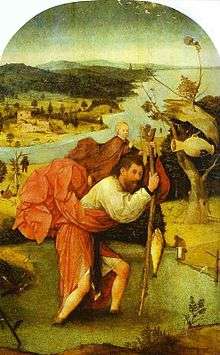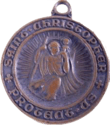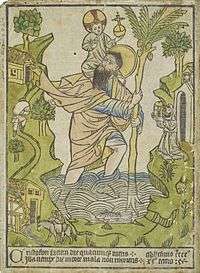Saint Christopher
Saint Christopher (Greek: Ἅγιος Χριστόφορος, Ágios Christóforos) is venerated by several Christian denominations as a martyr killed in the reign of the 3rd-century Roman Emperor Decius (reigned 249–251) or alternatively under the Roman Emperor Maximinus II Dacian (reigned 308–313). There appears to be confusion due to the similarity in names "Decius" and "Dacian".[3] However, his veneration only appears late in Christian tradition, and did not become widespread in the Western Church until the Late Middle Ages, although churches and monasteries were named after him by the 7th century.
Saint Christopher | |
|---|---|
 St. Christopher Carrying the Christ Child, by Hieronymus Bosch (c. 1485) | |
| Martyr | |
| Born | unknown Canaan (Western accounts) or Marmarica (Eastern accounts) |
| Died | c. 251 Asia Minor |
| Venerated in | |
| Feast |
|
| Attributes | tree, branch, as a giant or ogre, carrying Jesus, spear, shield, as a dog-headed man |
| Patronage | athletics, bachelors, transportation (drivers, sailors, etc.), traveling (especially for long journeys), surfing, storms, Brunswick, Saint Christopher's Island (Saint Kitts), Island Rab, Vilnius, epilepsy, gardeners, toothache |
His most famous legend tells that he carried a child, who was unknown to him, across a river before the child revealed himself as Christ. Therefore, he is the patron saint of travelers, and small images of him are often worn around the neck, on a bracelet, carried in a pocket, or placed in vehicles by Christians.
Legend
Legends about the life and death of Saint Christopher first appeared in Greece in the 6th century and had spread to France by the 9th century.[4] The 11th-century bishop and poet Walter of Speyer gave one version, but the most popular variations originated from the 13th-century Golden Legend.[5]
According to the legendary account of his life Christopher was initially called Reprobus.[6] He was a Canaanite, 5 cubits (7.5 feet (2.3 m)) tall and with a fearsome face. While serving the king of Canaan, he took it into his head to go and serve "the greatest king there was". He went to the king who was reputed to be the greatest, but one day he saw the king cross himself at the mention of the devil. On thus learning that the king feared the devil, he departed to look for the devil. He came across a band of marauders, one of whom declared himself to be the devil, so Christopher decided to serve him. But when he saw his new master avoid a wayside cross and found out that the devil feared Christ, he left him and enquired from people where to find Christ. He met a hermit who instructed him in the Christian faith. Christopher asked him how he could serve Christ. When the hermit suggested fasting and prayer, Christopher replied that he was unable to perform that service. The hermit then suggested that because of his size and strength Christopher could serve Christ by assisting people to cross a dangerous river, where they were perishing in the attempt. The hermit promised that this service would be pleasing to Christ.
After Christopher had performed this service for some time, a little child asked him to take him across the river. During the crossing, the river became swollen and the child seemed as heavy as lead, so much that Christopher could scarcely carry him and found himself in great difficulty. When he finally reached the other side, he said to the child: "You have put me in the greatest danger. I do not think the whole world could have been as heavy on my shoulders as you were." The child replied: "You had on your shoulders not only the whole world but Him who made it. I am Christ your king, whom you are serving by this work." The child then vanished.[7] Christopher later visited Lycia and there comforted the Christians who were being martyred. Brought before the local king, he refused to sacrifice to the pagan gods. The king tried to win him by riches and by sending two beautiful women to tempt him. Christopher converted the women to Christianity, as he had already converted thousands in the city. The king ordered him to be killed. Various attempts failed, but finally Christopher was beheaded.[7]
Veneration and patronage
Eastern Orthodox liturgy
The Eastern Orthodox Church venerates Christopher of Lycea with a Feast Day on May 9. The liturgical reading and hymns refer to his imprisonment by Decius who tempts Christopher with harlots before ordering his beheading.[8] The Kontakion in the Fourth Tone (hymn) reads:
Thou who wast terrifying both in strength and in countenance, for thy Creator's sake thou didst surrender thyself willingly to them that sought thee; for thou didst persuade both them and the women that sought to arouse in thee the fire of lust, and they followed thee in the path of martyrdom. And in torments thou didst prove to be courageous. Wherefore, we have gained thee as our great protector, O great Christopher.[8]
Roman Catholic liturgy
The Roman Martyrology remembers him on 25 July.[9] The Tridentine Calendar commemorated him on the same day only in private Masses. By 1954 his commemoration had been extended to all Masses, but it was dropped in 1970 as part of the general reorganization of the calendar of the Roman rite as mandated by the motu proprio, Mysterii Paschalis. His commemoration was described to be not of Roman tradition, in view of the relatively late date (about 1550) and limited manner in which it was accepted into the Roman calendar,[10] but his feast continues to be observed locally.[11]
Relics
The Museum of Sacred Art at Saint Justine's Church (Sveti Justina) in Rab, Croatia claims a gold-plated reliquary holds the skull of St. Christopher. According to church tradition, a bishop showed the relics from the city wall in 1075 in order to end a siege of the city by an Italo-Norman army.[12][13]

Medals
Devotional medals with St. Christopher‘s name and image are commonly worn as pendants, especially by travelers, to show devotion and as a request for his blessing. Miniature statues are frequently displayed in automobiles. In French a widespread phrase for such medals is “Regarde St Christophe et va-t-en rassuré” (“Look at St Christopher and go on reassured”, sometimes translated as “Behold St Christopher and go your way in safety”); Saint Christopher medals and holy cards in Spanish have the phrase “Si en San Cristóbal confías, de accidente no morirás” (“If you trust St. Christopher, you won’t die in an accident”).[14]
General patronage
St. Christopher is a widely popular saint, especially revered by athletes, mariners, ferrymen, and travelers.[5] He is revered as one of the Fourteen Holy Helpers. He holds patronage of things related to travel and travelers—against lightning and pestilence—and patronage for archers; bachelors; boatmen; soldiers; bookbinders; epilepsy; floods; fruit dealers; fullers; gardeners; a holy death; mariners; market carriers; motorists and drivers; sailors; storms; surfers;[15] toothache; mountaineering; and transportation workers.
Patronage of places
Christopher is the patron saint of many places, including: Baden, Germany;[5] Barga, Italy; Brunswick, Germany;[5] Mecklenburg, Germany;[5] Rab, Croatia; Roermond, The Netherlands; Saint Christopher's Island (Saint Kitts); Toses in Catalonia, Spain; Mondim de Basto, Portugal; Agrinion, Greece; Vilnius, Lithuania; Riga, Latvia; Havana, Cuba; San Cristóbal, Dominican Republic; Paete, Laguna, Philippines and Tivim, Goa, India
Depictions in art
Because St. Christopher offered protection to travelers and against sudden death, many churches placed images or statues of him, usually opposite the south door, so he could be easily seen.[11] He is usually depicted as a giant of a man, with a child on his shoulder and a staff in one hand.[16] In England, there are more wall paintings of St. Christopher than of any other saint;[11] in 1904, Mrs. Collier, writing for the British Archaeological Association, reported 183 paintings, statues, and other representations of the saint, outnumbering all others except for the Virgin Mary.[17]
In Eastern Orthodox iconography (and sometimes in the Western), Saint Christopher is sometimes represented with the head of a dog. The background to the dog-headed Christopher is laid in the reign of the Emperor Diocletian, when a man named Reprebus, Rebrebus or Reprobus was captured in combat against tribes dwelling to the west of Egypt in Cyrenaica. To the unit of soldiers, according to the hagiographic narrative, was assigned the name numerus Marmaritarum or "Unit of the Marmaritae", which suggests an otherwise-unidentified "Marmaritae" (perhaps the same as the Marmaricae Berber tribe of Cyrenaica). He was reported to be of enormous size, with the head of a dog instead of a man, apparently a characteristic of the Marmaritae. This Byzantine depiction of St. Christopher as dog-headed resulted from their misinterpretation of the Latin term Cananeus (Canaanite) to read canineus (canine).[18]
According to the medieval Irish Passion of St. Christopher, "This Christopher was one of the Dog-heads, a race that had the heads of dogs and ate human flesh."[19] It was commonly accepted at the time that there were several types of races, the Cynocephalus, or dog headed people, being one of many believed to populate the world.
The German bishop and poet Walter of Speyer portrayed St. Christopher as a giant of a cynocephalic species in the land of the Chananeans who ate human flesh and barked. Eventually, Christopher met the Christ child, regretted his former behavior, and received baptism. He, too, was rewarded with a human appearance, whereupon he devoted his life to Christian service and became an athlete of God, one of the soldier-saints.[20]
Paintings of Saint Christopher
 Parish of Almenno San Salvatore (Bergamo), Italy.
Parish of Almenno San Salvatore (Bergamo), Italy. Saint Christopher by Hans Memling, ca. 1480
Saint Christopher by Hans Memling, ca. 1480 The earliest known woodcut, 1423, Buxheim, with hand-colouring
The earliest known woodcut, 1423, Buxheim, with hand-colouring St. Christopher, from the Westminster Psalter, c. 1250
St. Christopher, from the Westminster Psalter, c. 1250
In popular culture
- See Saint Christopher in popular culture
Honours
St. Christophor Island in Antarctica is named after the saint.
See also
- Acts of Andrew and Bartholomew
- Cynocephaly
- List of saints
- Statue of Saint Christopher, Charles Bridge
References
- (in Greek) Ὁ Ἅγιος Χριστοφόρος ὁ Μεγαλομάρτυρας. 9 Μαΐου. ΜΕΓΑΣ ΣΥΝΑΞΑΡΙΣΤΗΣ.
- https://st-takla.org/Saints/Coptic-Orthodox-Saints-Biography/Coptic-Saints-Story_879.html
- T.D. Barnes, The New Empire of Diocletian and Constantine (Cambridge, MA, 1982). pp. 65–66.
- "CATHOLIC ENCYCLOPEDIA: St. Christopher". www.newadvent.org.
- Mershman, F. (1908). St. Christopher. In The Catholic Encyclopedia. New York: Robert Appleton Company. Retrieved September 16, 2008
- "Weniger, Francis X., "St. Christopher, Martyr", (1876)".
- "St. Christopher", Lives of Saints, John J. Crawley & Co., Inc.
- "Christopher the Martyr of Lycea". Saints. Greek Orthodox Archdiocese of America. 2013. Retrieved April 16, 2013.
- Martyrologium Romanum (Libreria Editrice Vaticana, 2001 ISBN 978-88-209-7210-3)
- Calendarium Romanum (Libreria Editrice Vaticana, 1969), p. 131
- Butler, Alban (2000). Peter Doyle, Paul Burns (ed.). Butler's lives of the saints, Volume 7. Liturgical Press. pp. 198–199. ISBN 978-0-8146-2383-1. Retrieved 25 October 2010.
- "The legend of St. Christopher". rab-visit.com.
- Portal Grada Raba: Povijest 14. ZAŠTITNIK RABA SV. KRISTOFOR Naime, Rab su 14. 4. 1075. svojim lađama opkolili italski Normani. Nemoćni da se obrane od brojnog i naoružanog neprijatelja, rabljani pozvaše u pomoć svog zaštitnika, svetog Kristofora <…> Svečeva lubanja dospjela je u Rab i čuva se u muzeju sv. Justine, kao dragocjena relikvija.
- Mount, Toni (2016). A Year in the Life of Medieval England. Amberley Publishing. p. 169. ISBN 978-1-4456-5240-5.
- Dioces of Orange hosts First Annual Blessing of the Waves in Surf City Archived 2008-09-16 at the Wayback Machine, Roman Catholic Diocese of Orange, September 15, 2008
- Magill, Frank Northen; J. Moose; Alison Aves (1998). Dictionary of World Biography: The ancient world. Taylor & Francis. pp. 239–244. ISBN 978-0-89356-313-4. Retrieved 25 October 2010.
- Collier, Mrs. (1904). "Saint Christopher and Some Representations of Him in English Churches". Journal of the British Archaeological Association: 130–145. Retrieved 25 October 2010.
- Ross, L. (1996). Medieval Art: A Topical Dictionary. Westport. p. 50.
- "Irish Passion of St. Christopher". Archived from the original on 2013-07-29.
- Walter of Speyer, Vita et passio sancti Christopher martyris, 75.
Further reading
- Bouquet, John A. (1930). A People's Book of Saints. London: Longman's.
- Butler, Alban (1956). Thurston, Herbert J.; Attwater, Donald (eds.). Butler's lives of the saints. New York: Kenedy.
- Cunningham, Lawrence S. (1980). The meaning of saints. San Francisco: Harper & Row. ISBN 978-0-06-061649-6.
- de Voragine, Jacobus (1993). The golden legend: readings on the saints. William Ryan, trans. Princeton, NJ: Princeton Univ. Press. ISBN 978-0-691-00865-3.
- Weinstein, Donald; Bell, Rudolph M. (1982). Saints and society: the 2 worlds of western Christendom, 1000–1700. Chicago: Univ. of Chicago Pr. ISBN 978-0-226-89055-5.
- White, Helen (1963). Tudor Books of Saints and Martyrs. Madison: University of Wisconsin Press.
- Wilson, Stephen, ed. (1983). Saints and their cults: studies in religious sociology, folklore, and history. Cambridge: Cambridge University Press. ISBN 978-0-521-24978-2.
External links
| Wikimedia Commons has media related to Saint Christopher. |
- Saint Christopher—Website with information and references about St. Christopher
- "The Life of Saint Christopher", The Golden Legend or Lives of the Saints, Temple Classics, 1931 (Compiled by Jacobus de Voragine, translated by William Caxton) at the Fordham University Medieval Sourcebook
- Saint Christopher at the Christian Iconography web site
- St. Christopher in the Golden Legend: Latin original, English translation (Caxton)
- Irish "Passion of St. Christopher"
- Saint Christopher engraved by E. Sadeler from the De Verda Collection
- Understanding the dog headed Icon of Saint Christopher at Orthodox Arts Journal.
- . Encyclopædia Britannica. 6 (11th ed.). 1911. p. 295.